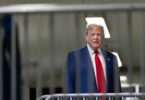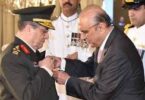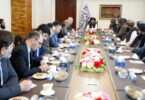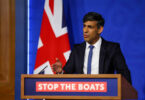Dr. Ramzy Baroud
German Chancellor Olaf Scholz was last week in Washington on an official visit that was aimed at working jointly with the US to make “sure that Israel has what it needs to defend itself,” according to White House spokesperson John Kirby. If this statement had been made soon after the Al-Aqsa Flood Operation of Oct. 7, one might have understood its logic, based on the well-known, inherent bias of both Washington and Berlin toward Israel. The statement and the visit, however, were conducted on the 125th day of one of the bloodiest genocides in modern history.
The purpose of the visit was highlighted in a press conference by Kirby, even though, hours later, US President Joe Biden admitted that Israel had gone “over the top” in its response to the Hamas attack. If killing or wounding more than 100,000 civilians, and counting, is Israel’s version of self-defense, then both Scholz and Biden have done a splendid job in ensuring Israel has everything it needs to achieve its bloody mission.
However, in this context, who is entitled to self-defense: Israel or Palestine? On a recent visit to a hospital in a Middle Eastern country, I witnessed one of the most horrific sights one could ever see: scores of limbless Palestinian children, some still fighting for their lives, some badly burned and others in a coma.
Those who were able to use their hands had drawn Palestinian flags, which hung on the walls beside their hospital beds. Some wore SpongeBob T-shirts and others hats bearing Disney characters. They were pure, innocent, and very much Palestinian. A couple of children flashed the victory sign as soon as we said our goodbyes. Little kids wanted to communicate to the world that they remain strong and that they know exactly who they are and where they come from. The children were far too young to realize the legal and political context of their strong feelings toward their homeland.
UN General Assembly Resolution 3236, passed in 1974, reaffirmed “the inalienable rights of the Palestinian people in Palestine, including: the right to self-determination … (and) the right to national independence and sovereignty.” The phrase “right to self-determination” is perhaps the most frequently uttered in relation to Palestine and the Palestinian struggle since the establishment of the UN.
The International Court of Justice last month also affirmed what we already know: that Palestinians are a distinct “national, ethnical, racial or religious group.” Those injured Palestinian children do not need legal language or political slogans to locate themselves. The right to live without fear of extermination, without bombs and without military occupation is a natural right, requiring no legal arguments, and is unfazed by racism, hate speech or propaganda. Unfortunately, we do not live in a world of common sense, but one of topsy-turvy legal and political systems that only cater to the strong.
In this parallel world, Scholz is more concerned about Israel being able to “defend itself” than a besieged Palestinian population, starving and bleeding, yet unable to achieve any tangible measure of justice. Despite this, Israel still does not have the right to defend itself. Logically, those carrying out acts of aggression should not demand that their victims refrain from fighting back. Palestinians have been victimized by Israeli colonialism, military occupation, racial apartheid, siege and now genocide. Therefore, for Israel to invoke Article 51 of Chapter VII of the UN Charter makes a mockery of international law. Article 51, which is often used by great powers to justify their wars and military interventions, was designed with a completely different legal spirit in mind.
Article 2 (4) of Chapter I in the UN Charter prohibits the “threat or use of force in international relations.” It also “calls on all members to respect the sovereignty, territorial integrity and political independence of other states.” Since Israel is in violation of Article 2 (4), it simply has no right to invoke Article 51. In November 2012, Palestine was recognized as an observer state at the UN. It is also a member of countless international treaties and is recognized by 139 of the 193 UN member states. Even if we accept the argument that the UN Charter only applies to full UN members, the Palestinian right to self-defense can still be established. In 1960, UNGA Resolution 1514 guaranteed independence to colonized nations and people. Although it did not discuss the right of the colonized to use force, it condemned the use of force against liberation movements.
Five years later, the UNGA voted in favor of Resolution 2105, which recognized the legitimacy of the “struggle” of colonized nations to exercise their right to self-determination. In 1983, the assembly passed Resolution 38/17. The language, this time, was unambiguous: people have the right to struggle against colonial foreign domination by all possible means, including armed struggle. The same dynamics that ruled the UN in its early days continue to this day, with Western countries, which represented the bulk of all colonial powers in the past, continuing to give themselves monopoly over the use of force. Conversely, the Global South, which has suffered under the yoke of those Western regimes, insists that it, too, has the right to defend itself against foreign intervention, colonialism, military occupation and apartheid. While Scholz was in Washington to discuss yet more ways to kill Palestinian civilians, Nicaragua made an official request to join South Africa in its effort to hold Israel accountable for the crime of genocide in Gaza. It is interesting how the colonizers and the colonized continue to build relations and solidarity around the same old principles. The Global South is, again, rising in solidarity with the Palestinians, while the Global North, with a few exceptions, continues to support Israeli oppression. Just before I left the hospital, a wounded child handed me a drawing. It featured several images, stacked one on top of the other, as if the little boy was creating a timeline of events that led to his injury: a tent, with him inside; an Israeli soldier shooting a Palestinian; prison bars, with his father inside; and, finally, a Palestinian fighter holding a flag.







